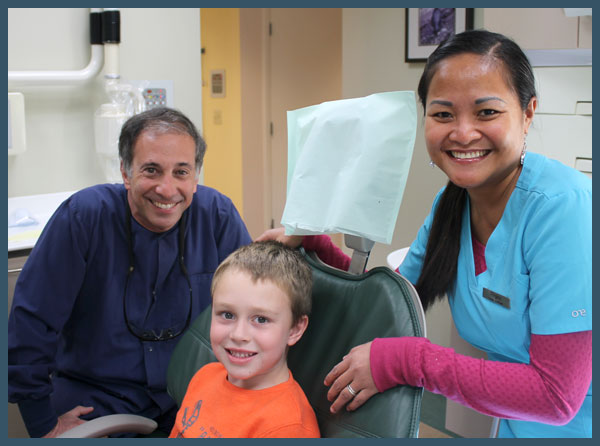Children’s Dentistry
 At the first visit the dental hygienist will gently introduce your child to our office. Our goal is to make this experience a pleasant one and foster a positive attitude toward the dentist. We never want going to the dentist to be a source of anxiety for anyone. You can help make your child’s first visit an enjoyable experience. We recommend educating your child about the dentist before the first visit. It is best if you refrain from using words that might cause unnecessary fear, such as needle, pain, drill or hurt.
At the first visit the dental hygienist will gently introduce your child to our office. Our goal is to make this experience a pleasant one and foster a positive attitude toward the dentist. We never want going to the dentist to be a source of anxiety for anyone. You can help make your child’s first visit an enjoyable experience. We recommend educating your child about the dentist before the first visit. It is best if you refrain from using words that might cause unnecessary fear, such as needle, pain, drill or hurt.
Explain that the dentist is there to check their teeth to make sure they are doing a good job taking care of them. Perhaps talk about the “Pictures” (x-rays) the dentist will show them of their teeth.
Taking Care Of Your Child’s Teeth
Brushing Tips:
- As soon as your child’s teeth erupt, brush them with a soft-bristled toothbrush.
- Under the age of 2, use a small “smear” of toothpaste.
- 2-5 years old, use a “pea-size” amount of toothpaste.
- Use an ADA-accepted fluoride toothpaste, and make sure your child does not swallow it.
- The parent should brush the child’s teeth until they are old enough to do a good job on their own.
Flossing Tips:
- Flossing removes plaque between teeth and under the gumline where a toothbrush can’t reach.
- Flossing should begin when any two teeth touch.
How Do I Prevent Cavities?
Good oral hygiene removes bacteria, and the left over food particles that combine to create cavities. Avoid putting your child to bed with a bottle filled with anything other than water.
For older children, brush their teeth at least twice a day. Limit the number of sugary snacks they eat.
Scheduling routine visits every six months to the dentist, starts your child on a lifetime of good dental health.
We may also recommend protective sealants or fluoride treatments for your child. Sealants can be applied to your child’s molars, to prevent tooth decay on those hard to clean back teeth. These teeth have tiny grooves that form as each tooth develops. A sealant is a protective coating that is applied to the chewing surfaces (grooves) of the back teeth, where four out of five cavities in children are found. This sealant acts as a barrier keeping food and bacteria from getting into the tiny grooves in the teeth and causing decay.
